Hospitality Destination Planning and Development
VerifiedAdded on 2023/01/06
|9
|3078
|46
AI Summary
This report discusses the policy approaches, importance of holistic tourism planning, and the role of tourism planning in destination development and regeneration. It focuses on the sustainable development of London's tourism industry and its impact on the economy, environment, and local communities.
Contribute Materials
Your contribution can guide someone’s learning journey. Share your
documents today.
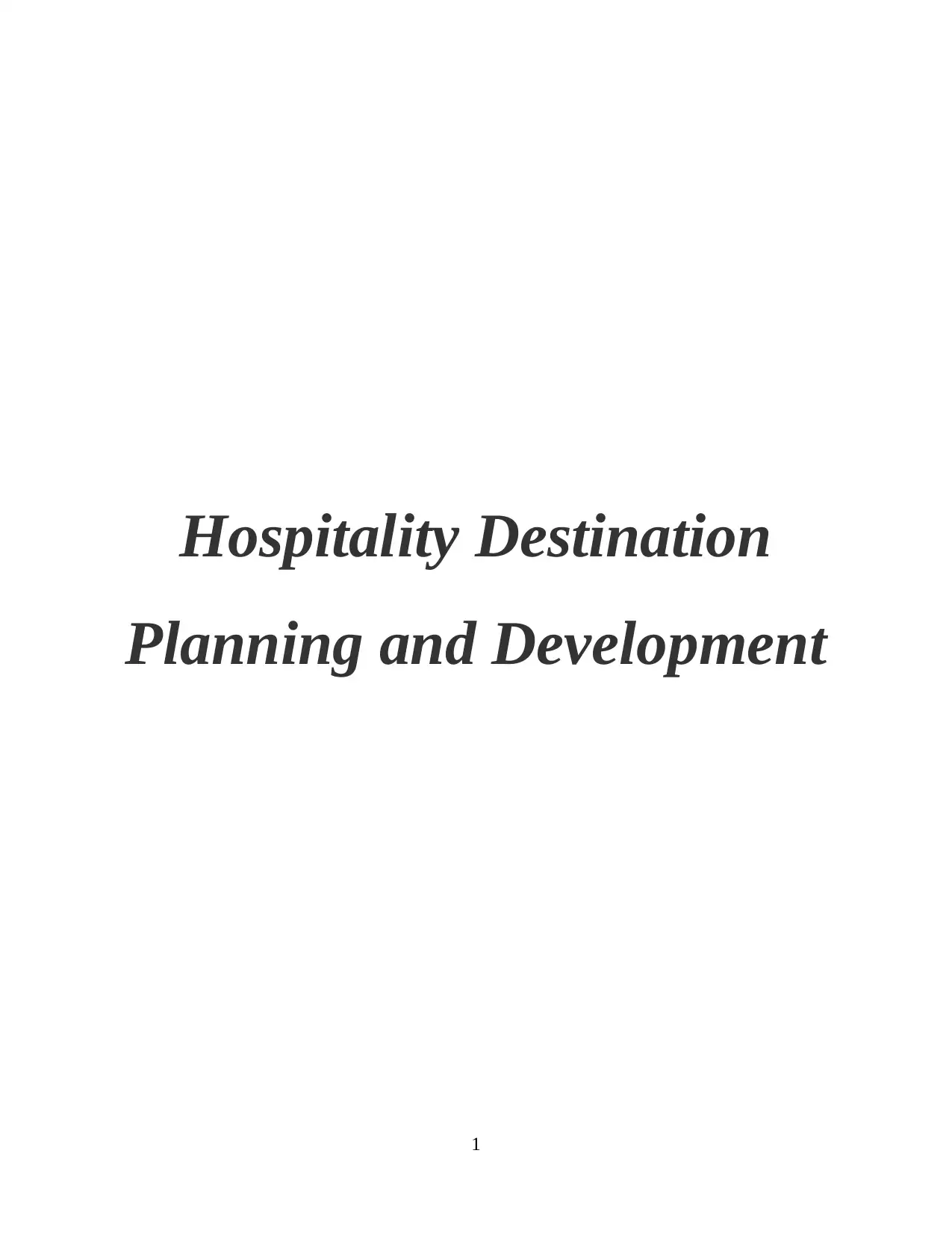
Hospitality Destination
Planning and Development
1
Planning and Development
1
Secure Best Marks with AI Grader
Need help grading? Try our AI Grader for instant feedback on your assignments.
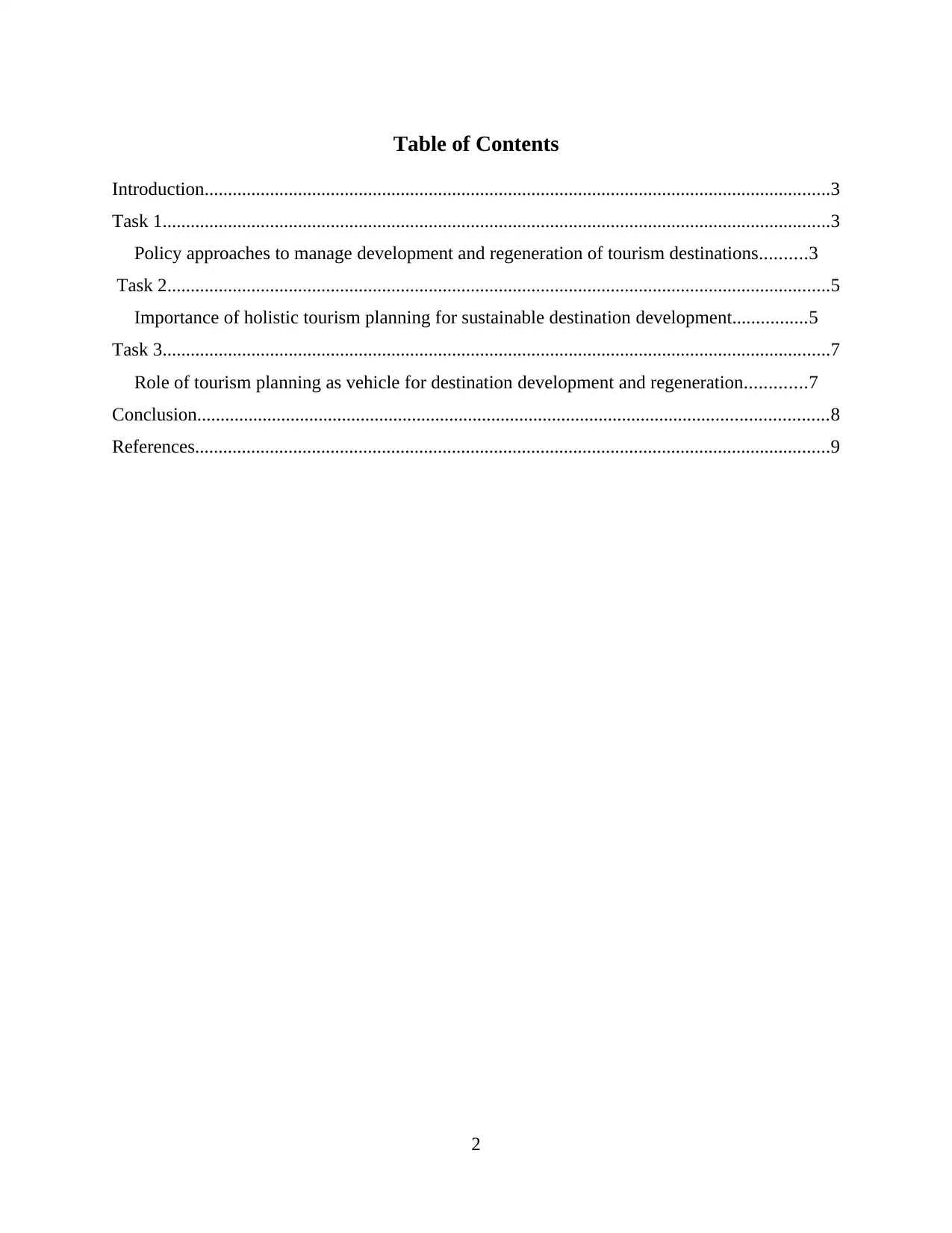
Table of Contents
Introduction......................................................................................................................................3
Task 1...............................................................................................................................................3
Policy approaches to manage development and regeneration of tourism destinations..........3
Task 2..............................................................................................................................................5
Importance of holistic tourism planning for sustainable destination development................5
Task 3...............................................................................................................................................7
Role of tourism planning as vehicle for destination development and regeneration.............7
Conclusion.......................................................................................................................................8
References........................................................................................................................................9
2
Introduction......................................................................................................................................3
Task 1...............................................................................................................................................3
Policy approaches to manage development and regeneration of tourism destinations..........3
Task 2..............................................................................................................................................5
Importance of holistic tourism planning for sustainable destination development................5
Task 3...............................................................................................................................................7
Role of tourism planning as vehicle for destination development and regeneration.............7
Conclusion.......................................................................................................................................8
References........................................................................................................................................9
2
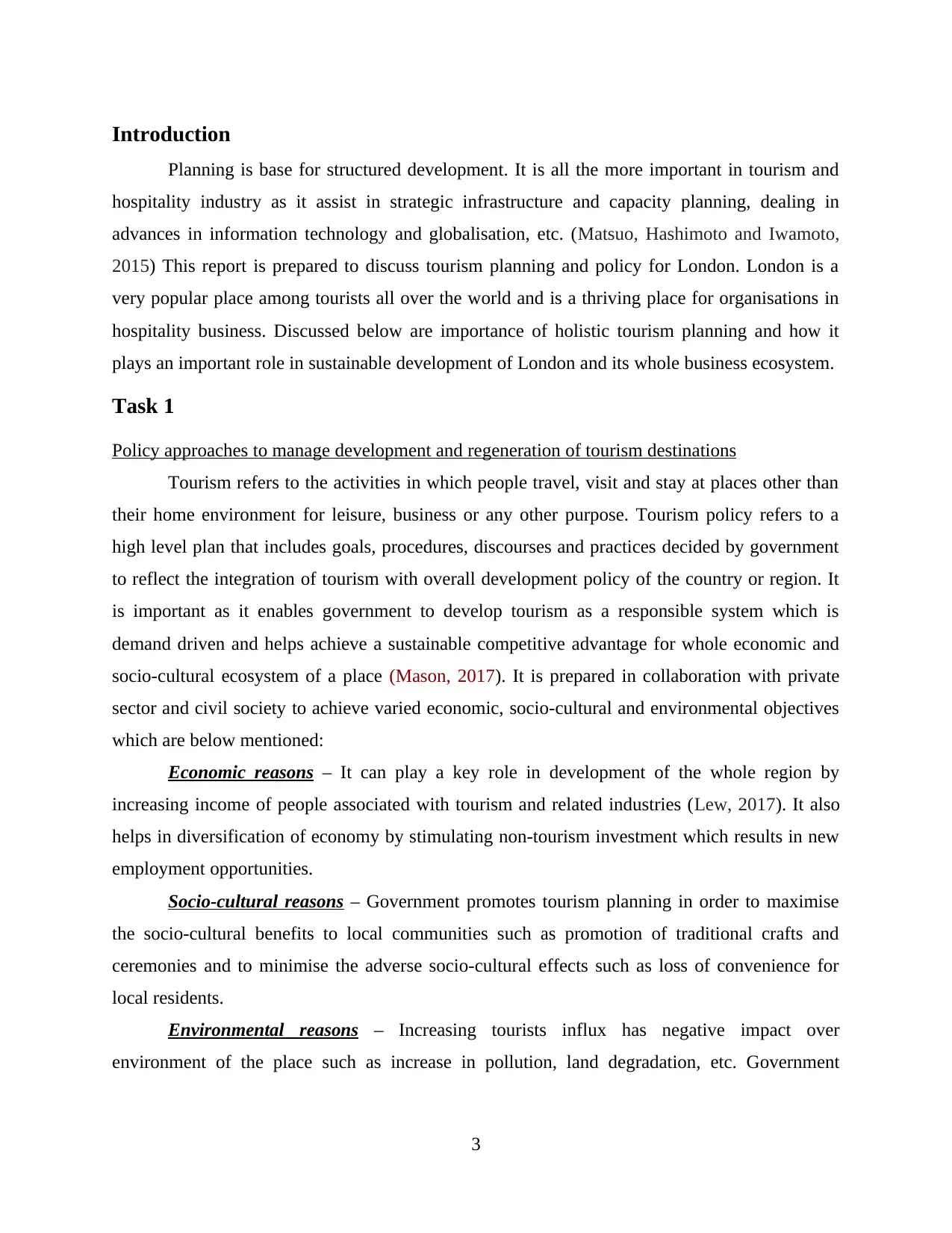
Introduction
Planning is base for structured development. It is all the more important in tourism and
hospitality industry as it assist in strategic infrastructure and capacity planning, dealing in
advances in information technology and globalisation, etc. (Matsuo, Hashimoto and Iwamoto,
2015) This report is prepared to discuss tourism planning and policy for London. London is a
very popular place among tourists all over the world and is a thriving place for organisations in
hospitality business. Discussed below are importance of holistic tourism planning and how it
plays an important role in sustainable development of London and its whole business ecosystem.
Task 1
Policy approaches to manage development and regeneration of tourism destinations
Tourism refers to the activities in which people travel, visit and stay at places other than
their home environment for leisure, business or any other purpose. Tourism policy refers to a
high level plan that includes goals, procedures, discourses and practices decided by government
to reflect the integration of tourism with overall development policy of the country or region. It
is important as it enables government to develop tourism as a responsible system which is
demand driven and helps achieve a sustainable competitive advantage for whole economic and
socio-cultural ecosystem of a place (Mason, 2017). It is prepared in collaboration with private
sector and civil society to achieve varied economic, socio-cultural and environmental objectives
which are below mentioned:
Economic reasons – It can play a key role in development of the whole region by
increasing income of people associated with tourism and related industries (Lew, 2017). It also
helps in diversification of economy by stimulating non-tourism investment which results in new
employment opportunities.
Socio-cultural reasons – Government promotes tourism planning in order to maximise
the socio-cultural benefits to local communities such as promotion of traditional crafts and
ceremonies and to minimise the adverse socio-cultural effects such as loss of convenience for
local residents.
Environmental reasons – Increasing tourists influx has negative impact over
environment of the place such as increase in pollution, land degradation, etc. Government
3
Planning is base for structured development. It is all the more important in tourism and
hospitality industry as it assist in strategic infrastructure and capacity planning, dealing in
advances in information technology and globalisation, etc. (Matsuo, Hashimoto and Iwamoto,
2015) This report is prepared to discuss tourism planning and policy for London. London is a
very popular place among tourists all over the world and is a thriving place for organisations in
hospitality business. Discussed below are importance of holistic tourism planning and how it
plays an important role in sustainable development of London and its whole business ecosystem.
Task 1
Policy approaches to manage development and regeneration of tourism destinations
Tourism refers to the activities in which people travel, visit and stay at places other than
their home environment for leisure, business or any other purpose. Tourism policy refers to a
high level plan that includes goals, procedures, discourses and practices decided by government
to reflect the integration of tourism with overall development policy of the country or region. It
is important as it enables government to develop tourism as a responsible system which is
demand driven and helps achieve a sustainable competitive advantage for whole economic and
socio-cultural ecosystem of a place (Mason, 2017). It is prepared in collaboration with private
sector and civil society to achieve varied economic, socio-cultural and environmental objectives
which are below mentioned:
Economic reasons – It can play a key role in development of the whole region by
increasing income of people associated with tourism and related industries (Lew, 2017). It also
helps in diversification of economy by stimulating non-tourism investment which results in new
employment opportunities.
Socio-cultural reasons – Government promotes tourism planning in order to maximise
the socio-cultural benefits to local communities such as promotion of traditional crafts and
ceremonies and to minimise the adverse socio-cultural effects such as loss of convenience for
local residents.
Environmental reasons – Increasing tourists influx has negative impact over
environment of the place such as increase in pollution, land degradation, etc. Government
3
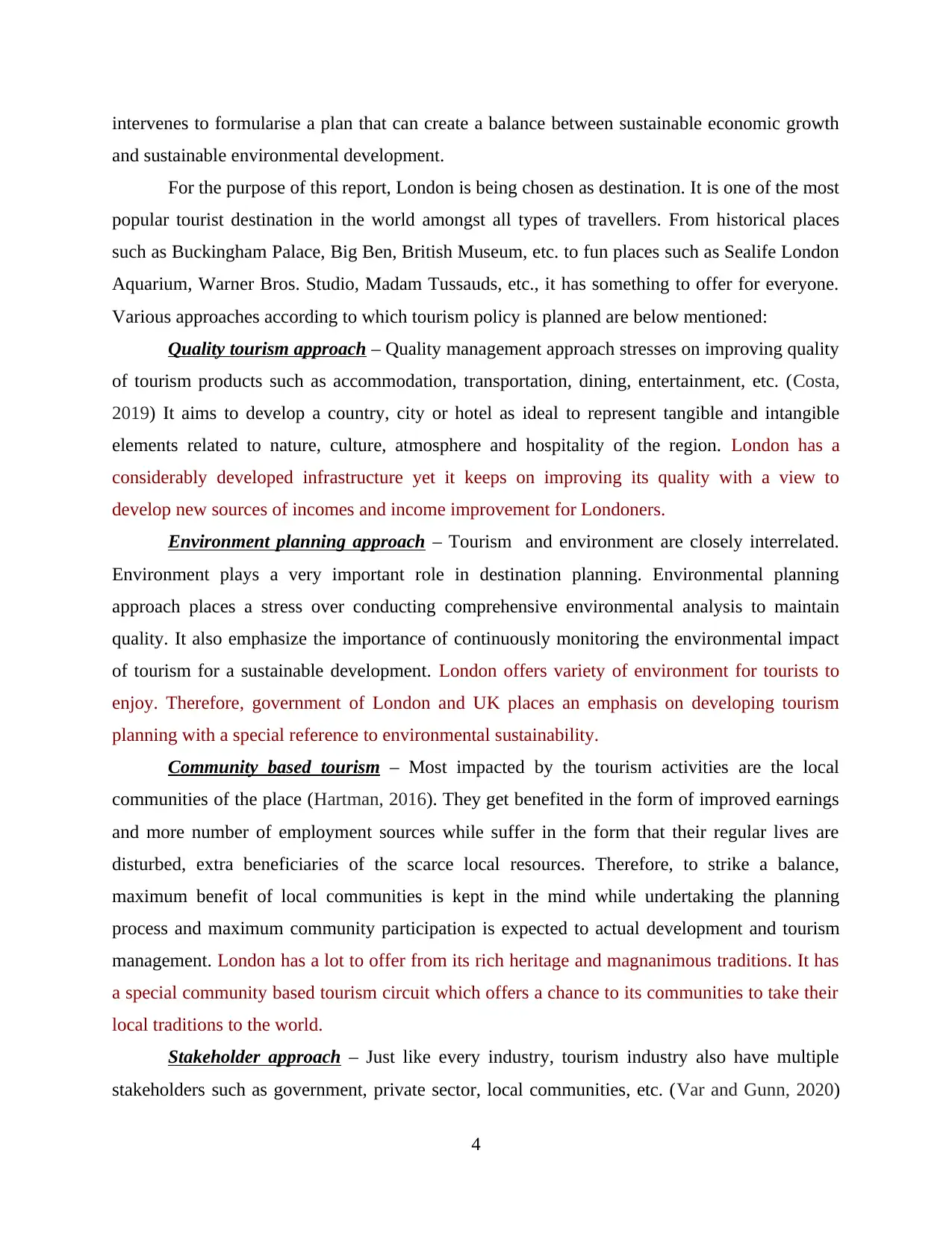
intervenes to formularise a plan that can create a balance between sustainable economic growth
and sustainable environmental development.
For the purpose of this report, London is being chosen as destination. It is one of the most
popular tourist destination in the world amongst all types of travellers. From historical places
such as Buckingham Palace, Big Ben, British Museum, etc. to fun places such as Sealife London
Aquarium, Warner Bros. Studio, Madam Tussauds, etc., it has something to offer for everyone.
Various approaches according to which tourism policy is planned are below mentioned:
Quality tourism approach – Quality management approach stresses on improving quality
of tourism products such as accommodation, transportation, dining, entertainment, etc. (Costa,
2019) It aims to develop a country, city or hotel as ideal to represent tangible and intangible
elements related to nature, culture, atmosphere and hospitality of the region. London has a
considerably developed infrastructure yet it keeps on improving its quality with a view to
develop new sources of incomes and income improvement for Londoners.
Environment planning approach – Tourism and environment are closely interrelated.
Environment plays a very important role in destination planning. Environmental planning
approach places a stress over conducting comprehensive environmental analysis to maintain
quality. It also emphasize the importance of continuously monitoring the environmental impact
of tourism for a sustainable development. London offers variety of environment for tourists to
enjoy. Therefore, government of London and UK places an emphasis on developing tourism
planning with a special reference to environmental sustainability.
Community based tourism – Most impacted by the tourism activities are the local
communities of the place (Hartman, 2016). They get benefited in the form of improved earnings
and more number of employment sources while suffer in the form that their regular lives are
disturbed, extra beneficiaries of the scarce local resources. Therefore, to strike a balance,
maximum benefit of local communities is kept in the mind while undertaking the planning
process and maximum community participation is expected to actual development and tourism
management. London has a lot to offer from its rich heritage and magnanimous traditions. It has
a special community based tourism circuit which offers a chance to its communities to take their
local traditions to the world.
Stakeholder approach – Just like every industry, tourism industry also have multiple
stakeholders such as government, private sector, local communities, etc. (Var and Gunn, 2020)
4
and sustainable environmental development.
For the purpose of this report, London is being chosen as destination. It is one of the most
popular tourist destination in the world amongst all types of travellers. From historical places
such as Buckingham Palace, Big Ben, British Museum, etc. to fun places such as Sealife London
Aquarium, Warner Bros. Studio, Madam Tussauds, etc., it has something to offer for everyone.
Various approaches according to which tourism policy is planned are below mentioned:
Quality tourism approach – Quality management approach stresses on improving quality
of tourism products such as accommodation, transportation, dining, entertainment, etc. (Costa,
2019) It aims to develop a country, city or hotel as ideal to represent tangible and intangible
elements related to nature, culture, atmosphere and hospitality of the region. London has a
considerably developed infrastructure yet it keeps on improving its quality with a view to
develop new sources of incomes and income improvement for Londoners.
Environment planning approach – Tourism and environment are closely interrelated.
Environment plays a very important role in destination planning. Environmental planning
approach places a stress over conducting comprehensive environmental analysis to maintain
quality. It also emphasize the importance of continuously monitoring the environmental impact
of tourism for a sustainable development. London offers variety of environment for tourists to
enjoy. Therefore, government of London and UK places an emphasis on developing tourism
planning with a special reference to environmental sustainability.
Community based tourism – Most impacted by the tourism activities are the local
communities of the place (Hartman, 2016). They get benefited in the form of improved earnings
and more number of employment sources while suffer in the form that their regular lives are
disturbed, extra beneficiaries of the scarce local resources. Therefore, to strike a balance,
maximum benefit of local communities is kept in the mind while undertaking the planning
process and maximum community participation is expected to actual development and tourism
management. London has a lot to offer from its rich heritage and magnanimous traditions. It has
a special community based tourism circuit which offers a chance to its communities to take their
local traditions to the world.
Stakeholder approach – Just like every industry, tourism industry also have multiple
stakeholders such as government, private sector, local communities, etc. (Var and Gunn, 2020)
4
Secure Best Marks with AI Grader
Need help grading? Try our AI Grader for instant feedback on your assignments.

This approach is used while planning to ensure a sustainable development and promotion of
tourism among a wide range of public, private, social and voluntary organisations. While
planning for developing tourism in London, government ensures that it includes developmental
policies for all stakeholders according to their expectations.
Boosterism approach – Boosterism comes from boost. This approach suggests that more
tourists would mean more development and benefits that would exceed costs. Thus, this
approach involves huge stress over marketing activities and is planned to promote the hospitality
industry including hotels, restaurants, travel business, etc. with a very little focus on the net
economic, socio-cultural or environmental impacts brought by it. Government of London plans
for cost based marketing approach in such a way that tourist spread positive words about London
on their own and returns for multiple time along with new visitors, irrespective of the impact it
lays on natural and artificial resources of London..
Economic approach – This approach assumes tourism as an industry and is used as a tool
to promote growth and development of the economy (Nunkoo and Gursoy, 2016). It is closely
related to boosterism approach and lay stress over marketing and development of tourism
industry and its multiplier effect over allied industries. It gives little importance to satisfaction
and attitude of local communities. This approach is visible in tourism planning by government of
London while wielding impact of domino effect of tourism industry and multiplier results that it
has.
Tourism policy of London doesn't reflect single approach rather combines all to create a
policy that has goodness of quality service without hurting the economic sentiments of all the
stakeholders. It emphasizes on developing infrastructure in balance with sustainable
development of environmental resources. It places a huge stress on celebrating their local
history, traditions and culture while including incorporating current development in tastes and
lifestyles of tourists.
Task 2
Importance of holistic tourism planning for sustainable destination development
Holistic refers to a concept that suggests that all phenomenons are interconnected and
interdependent on a single scientific discipline (Shoeb-Ur-Rahman and et.al., 2020). In tourism
planning, a plan cannot be merely said holistic if it considers only economic phenomenon
5
tourism among a wide range of public, private, social and voluntary organisations. While
planning for developing tourism in London, government ensures that it includes developmental
policies for all stakeholders according to their expectations.
Boosterism approach – Boosterism comes from boost. This approach suggests that more
tourists would mean more development and benefits that would exceed costs. Thus, this
approach involves huge stress over marketing activities and is planned to promote the hospitality
industry including hotels, restaurants, travel business, etc. with a very little focus on the net
economic, socio-cultural or environmental impacts brought by it. Government of London plans
for cost based marketing approach in such a way that tourist spread positive words about London
on their own and returns for multiple time along with new visitors, irrespective of the impact it
lays on natural and artificial resources of London..
Economic approach – This approach assumes tourism as an industry and is used as a tool
to promote growth and development of the economy (Nunkoo and Gursoy, 2016). It is closely
related to boosterism approach and lay stress over marketing and development of tourism
industry and its multiplier effect over allied industries. It gives little importance to satisfaction
and attitude of local communities. This approach is visible in tourism planning by government of
London while wielding impact of domino effect of tourism industry and multiplier results that it
has.
Tourism policy of London doesn't reflect single approach rather combines all to create a
policy that has goodness of quality service without hurting the economic sentiments of all the
stakeholders. It emphasizes on developing infrastructure in balance with sustainable
development of environmental resources. It places a huge stress on celebrating their local
history, traditions and culture while including incorporating current development in tastes and
lifestyles of tourists.
Task 2
Importance of holistic tourism planning for sustainable destination development
Holistic refers to a concept that suggests that all phenomenons are interconnected and
interdependent on a single scientific discipline (Shoeb-Ur-Rahman and et.al., 2020). In tourism
planning, a plan cannot be merely said holistic if it considers only economic phenomenon
5
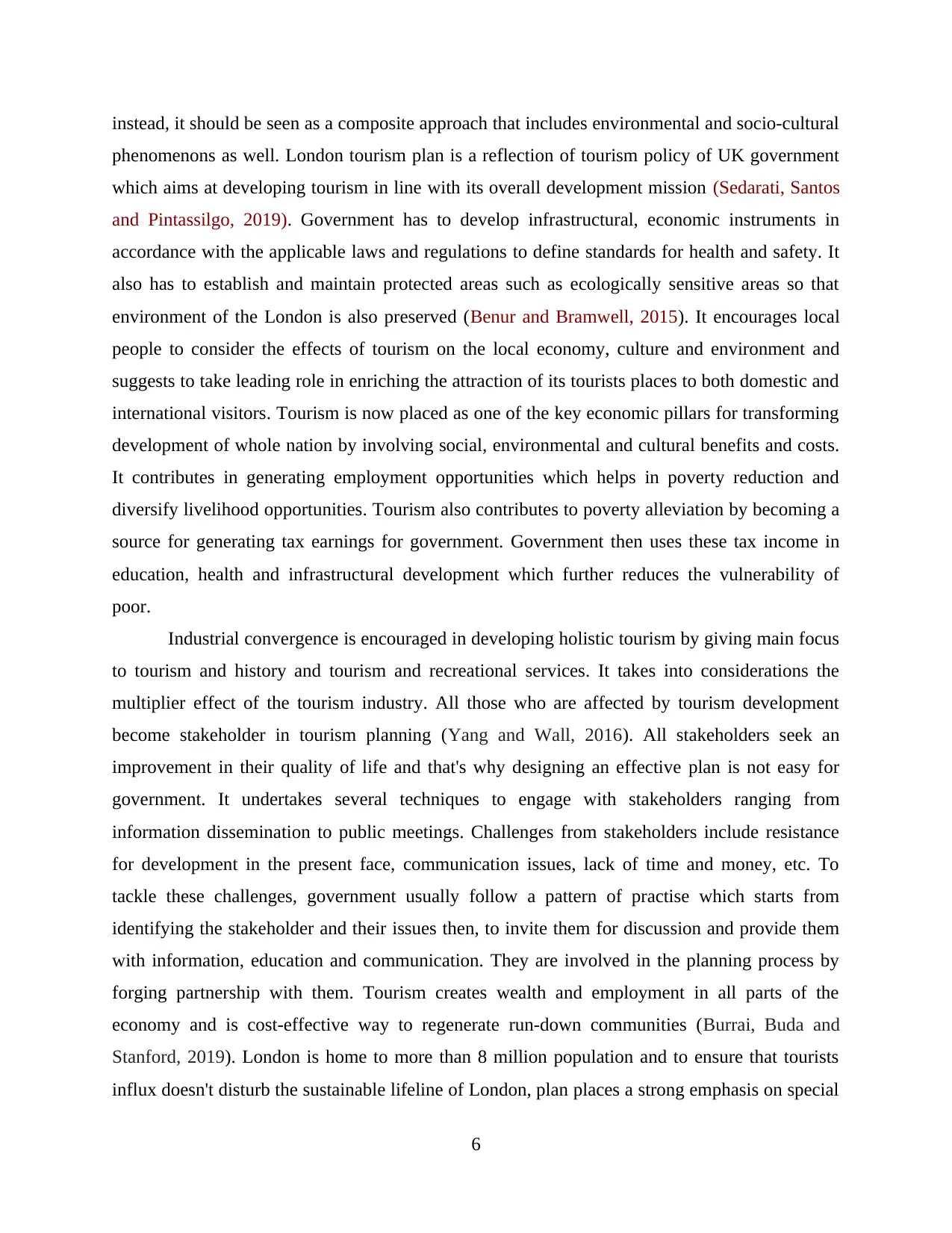
instead, it should be seen as a composite approach that includes environmental and socio-cultural
phenomenons as well. London tourism plan is a reflection of tourism policy of UK government
which aims at developing tourism in line with its overall development mission (Sedarati, Santos
and Pintassilgo, 2019). Government has to develop infrastructural, economic instruments in
accordance with the applicable laws and regulations to define standards for health and safety. It
also has to establish and maintain protected areas such as ecologically sensitive areas so that
environment of the London is also preserved (Benur and Bramwell, 2015). It encourages local
people to consider the effects of tourism on the local economy, culture and environment and
suggests to take leading role in enriching the attraction of its tourists places to both domestic and
international visitors. Tourism is now placed as one of the key economic pillars for transforming
development of whole nation by involving social, environmental and cultural benefits and costs.
It contributes in generating employment opportunities which helps in poverty reduction and
diversify livelihood opportunities. Tourism also contributes to poverty alleviation by becoming a
source for generating tax earnings for government. Government then uses these tax income in
education, health and infrastructural development which further reduces the vulnerability of
poor.
Industrial convergence is encouraged in developing holistic tourism by giving main focus
to tourism and history and tourism and recreational services. It takes into considerations the
multiplier effect of the tourism industry. All those who are affected by tourism development
become stakeholder in tourism planning (Yang and Wall, 2016). All stakeholders seek an
improvement in their quality of life and that's why designing an effective plan is not easy for
government. It undertakes several techniques to engage with stakeholders ranging from
information dissemination to public meetings. Challenges from stakeholders include resistance
for development in the present face, communication issues, lack of time and money, etc. To
tackle these challenges, government usually follow a pattern of practise which starts from
identifying the stakeholder and their issues then, to invite them for discussion and provide them
with information, education and communication. They are involved in the planning process by
forging partnership with them. Tourism creates wealth and employment in all parts of the
economy and is cost-effective way to regenerate run-down communities (Burrai, Buda and
Stanford, 2019). London is home to more than 8 million population and to ensure that tourists
influx doesn't disturb the sustainable lifeline of London, plan places a strong emphasis on special
6
phenomenons as well. London tourism plan is a reflection of tourism policy of UK government
which aims at developing tourism in line with its overall development mission (Sedarati, Santos
and Pintassilgo, 2019). Government has to develop infrastructural, economic instruments in
accordance with the applicable laws and regulations to define standards for health and safety. It
also has to establish and maintain protected areas such as ecologically sensitive areas so that
environment of the London is also preserved (Benur and Bramwell, 2015). It encourages local
people to consider the effects of tourism on the local economy, culture and environment and
suggests to take leading role in enriching the attraction of its tourists places to both domestic and
international visitors. Tourism is now placed as one of the key economic pillars for transforming
development of whole nation by involving social, environmental and cultural benefits and costs.
It contributes in generating employment opportunities which helps in poverty reduction and
diversify livelihood opportunities. Tourism also contributes to poverty alleviation by becoming a
source for generating tax earnings for government. Government then uses these tax income in
education, health and infrastructural development which further reduces the vulnerability of
poor.
Industrial convergence is encouraged in developing holistic tourism by giving main focus
to tourism and history and tourism and recreational services. It takes into considerations the
multiplier effect of the tourism industry. All those who are affected by tourism development
become stakeholder in tourism planning (Yang and Wall, 2016). All stakeholders seek an
improvement in their quality of life and that's why designing an effective plan is not easy for
government. It undertakes several techniques to engage with stakeholders ranging from
information dissemination to public meetings. Challenges from stakeholders include resistance
for development in the present face, communication issues, lack of time and money, etc. To
tackle these challenges, government usually follow a pattern of practise which starts from
identifying the stakeholder and their issues then, to invite them for discussion and provide them
with information, education and communication. They are involved in the planning process by
forging partnership with them. Tourism creates wealth and employment in all parts of the
economy and is cost-effective way to regenerate run-down communities (Burrai, Buda and
Stanford, 2019). London is home to more than 8 million population and to ensure that tourists
influx doesn't disturb the sustainable lifeline of London, plan places a strong emphasis on special
6
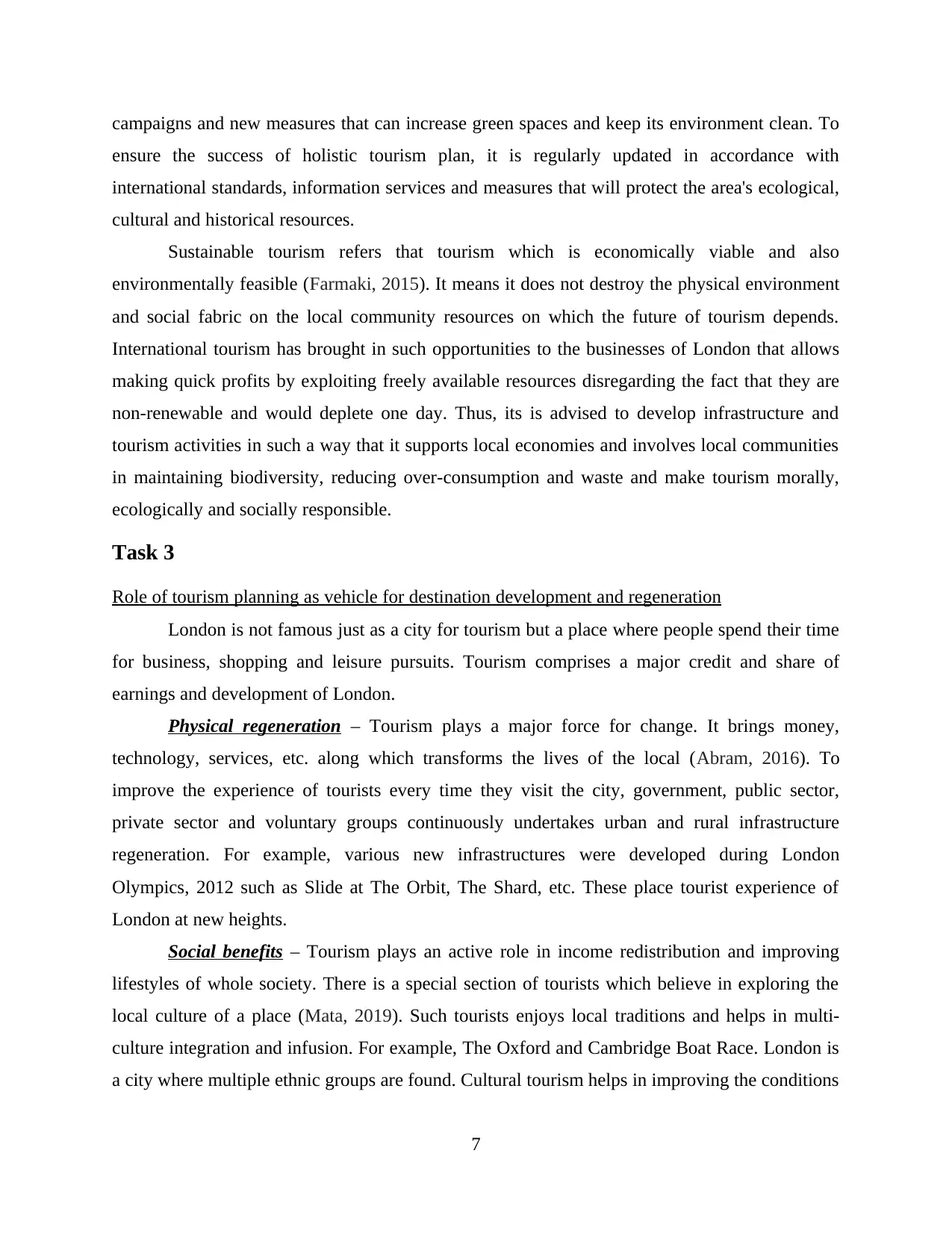
campaigns and new measures that can increase green spaces and keep its environment clean. To
ensure the success of holistic tourism plan, it is regularly updated in accordance with
international standards, information services and measures that will protect the area's ecological,
cultural and historical resources.
Sustainable tourism refers that tourism which is economically viable and also
environmentally feasible (Farmaki, 2015). It means it does not destroy the physical environment
and social fabric on the local community resources on which the future of tourism depends.
International tourism has brought in such opportunities to the businesses of London that allows
making quick profits by exploiting freely available resources disregarding the fact that they are
non-renewable and would deplete one day. Thus, its is advised to develop infrastructure and
tourism activities in such a way that it supports local economies and involves local communities
in maintaining biodiversity, reducing over-consumption and waste and make tourism morally,
ecologically and socially responsible.
Task 3
Role of tourism planning as vehicle for destination development and regeneration
London is not famous just as a city for tourism but a place where people spend their time
for business, shopping and leisure pursuits. Tourism comprises a major credit and share of
earnings and development of London.
Physical regeneration – Tourism plays a major force for change. It brings money,
technology, services, etc. along which transforms the lives of the local (Abram, 2016). To
improve the experience of tourists every time they visit the city, government, public sector,
private sector and voluntary groups continuously undertakes urban and rural infrastructure
regeneration. For example, various new infrastructures were developed during London
Olympics, 2012 such as Slide at The Orbit, The Shard, etc. These place tourist experience of
London at new heights.
Social benefits – Tourism plays an active role in income redistribution and improving
lifestyles of whole society. There is a special section of tourists which believe in exploring the
local culture of a place (Mata, 2019). Such tourists enjoys local traditions and helps in multi-
culture integration and infusion. For example, The Oxford and Cambridge Boat Race. London is
a city where multiple ethnic groups are found. Cultural tourism helps in improving the conditions
7
ensure the success of holistic tourism plan, it is regularly updated in accordance with
international standards, information services and measures that will protect the area's ecological,
cultural and historical resources.
Sustainable tourism refers that tourism which is economically viable and also
environmentally feasible (Farmaki, 2015). It means it does not destroy the physical environment
and social fabric on the local community resources on which the future of tourism depends.
International tourism has brought in such opportunities to the businesses of London that allows
making quick profits by exploiting freely available resources disregarding the fact that they are
non-renewable and would deplete one day. Thus, its is advised to develop infrastructure and
tourism activities in such a way that it supports local economies and involves local communities
in maintaining biodiversity, reducing over-consumption and waste and make tourism morally,
ecologically and socially responsible.
Task 3
Role of tourism planning as vehicle for destination development and regeneration
London is not famous just as a city for tourism but a place where people spend their time
for business, shopping and leisure pursuits. Tourism comprises a major credit and share of
earnings and development of London.
Physical regeneration – Tourism plays a major force for change. It brings money,
technology, services, etc. along which transforms the lives of the local (Abram, 2016). To
improve the experience of tourists every time they visit the city, government, public sector,
private sector and voluntary groups continuously undertakes urban and rural infrastructure
regeneration. For example, various new infrastructures were developed during London
Olympics, 2012 such as Slide at The Orbit, The Shard, etc. These place tourist experience of
London at new heights.
Social benefits – Tourism plays an active role in income redistribution and improving
lifestyles of whole society. There is a special section of tourists which believe in exploring the
local culture of a place (Mata, 2019). Such tourists enjoys local traditions and helps in multi-
culture integration and infusion. For example, The Oxford and Cambridge Boat Race. London is
a city where multiple ethnic groups are found. Cultural tourism helps in improving the conditions
7
Paraphrase This Document
Need a fresh take? Get an instant paraphrase of this document with our AI Paraphraser
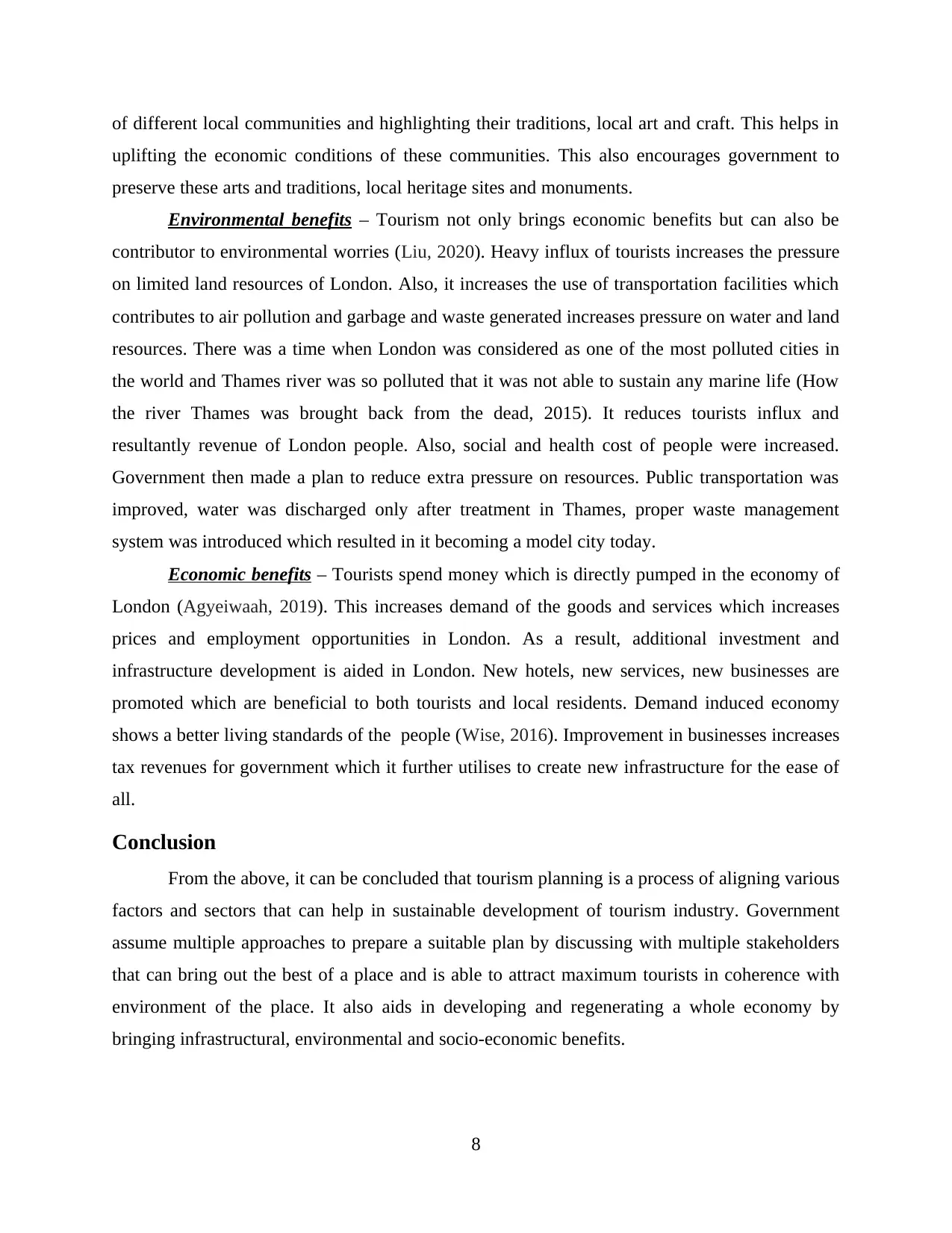
of different local communities and highlighting their traditions, local art and craft. This helps in
uplifting the economic conditions of these communities. This also encourages government to
preserve these arts and traditions, local heritage sites and monuments.
Environmental benefits – Tourism not only brings economic benefits but can also be
contributor to environmental worries (Liu, 2020). Heavy influx of tourists increases the pressure
on limited land resources of London. Also, it increases the use of transportation facilities which
contributes to air pollution and garbage and waste generated increases pressure on water and land
resources. There was a time when London was considered as one of the most polluted cities in
the world and Thames river was so polluted that it was not able to sustain any marine life (How
the river Thames was brought back from the dead, 2015). It reduces tourists influx and
resultantly revenue of London people. Also, social and health cost of people were increased.
Government then made a plan to reduce extra pressure on resources. Public transportation was
improved, water was discharged only after treatment in Thames, proper waste management
system was introduced which resulted in it becoming a model city today.
Economic benefits – Tourists spend money which is directly pumped in the economy of
London (Agyeiwaah, 2019). This increases demand of the goods and services which increases
prices and employment opportunities in London. As a result, additional investment and
infrastructure development is aided in London. New hotels, new services, new businesses are
promoted which are beneficial to both tourists and local residents. Demand induced economy
shows a better living standards of the people (Wise, 2016). Improvement in businesses increases
tax revenues for government which it further utilises to create new infrastructure for the ease of
all.
Conclusion
From the above, it can be concluded that tourism planning is a process of aligning various
factors and sectors that can help in sustainable development of tourism industry. Government
assume multiple approaches to prepare a suitable plan by discussing with multiple stakeholders
that can bring out the best of a place and is able to attract maximum tourists in coherence with
environment of the place. It also aids in developing and regenerating a whole economy by
bringing infrastructural, environmental and socio-economic benefits.
8
uplifting the economic conditions of these communities. This also encourages government to
preserve these arts and traditions, local heritage sites and monuments.
Environmental benefits – Tourism not only brings economic benefits but can also be
contributor to environmental worries (Liu, 2020). Heavy influx of tourists increases the pressure
on limited land resources of London. Also, it increases the use of transportation facilities which
contributes to air pollution and garbage and waste generated increases pressure on water and land
resources. There was a time when London was considered as one of the most polluted cities in
the world and Thames river was so polluted that it was not able to sustain any marine life (How
the river Thames was brought back from the dead, 2015). It reduces tourists influx and
resultantly revenue of London people. Also, social and health cost of people were increased.
Government then made a plan to reduce extra pressure on resources. Public transportation was
improved, water was discharged only after treatment in Thames, proper waste management
system was introduced which resulted in it becoming a model city today.
Economic benefits – Tourists spend money which is directly pumped in the economy of
London (Agyeiwaah, 2019). This increases demand of the goods and services which increases
prices and employment opportunities in London. As a result, additional investment and
infrastructure development is aided in London. New hotels, new services, new businesses are
promoted which are beneficial to both tourists and local residents. Demand induced economy
shows a better living standards of the people (Wise, 2016). Improvement in businesses increases
tax revenues for government which it further utilises to create new infrastructure for the ease of
all.
Conclusion
From the above, it can be concluded that tourism planning is a process of aligning various
factors and sectors that can help in sustainable development of tourism industry. Government
assume multiple approaches to prepare a suitable plan by discussing with multiple stakeholders
that can bring out the best of a place and is able to attract maximum tourists in coherence with
environment of the place. It also aids in developing and regenerating a whole economy by
bringing infrastructural, environmental and socio-economic benefits.
8
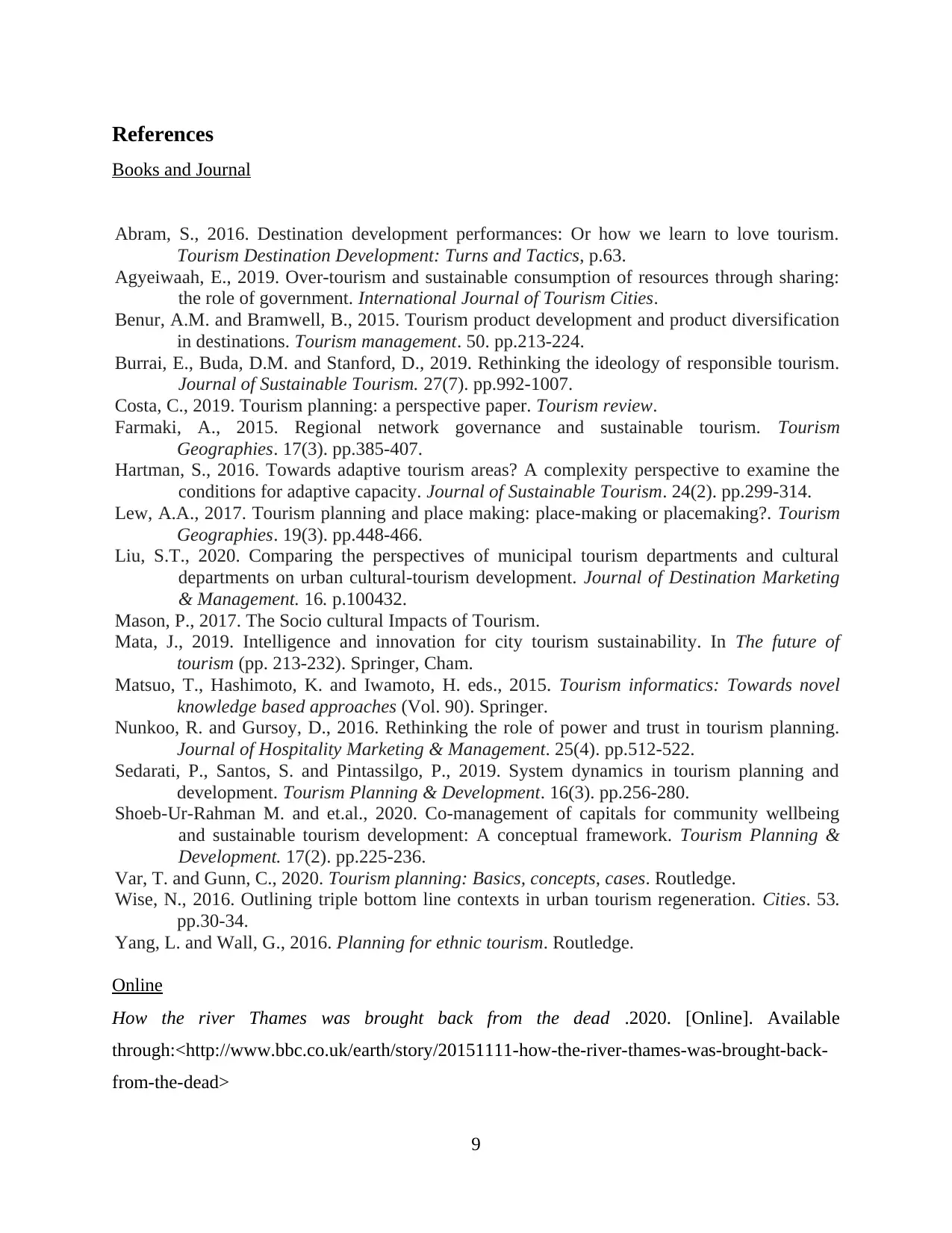
References
Books and Journal
Abram, S., 2016. Destination development performances: Or how we learn to love tourism.
Tourism Destination Development: Turns and Tactics, p.63.
Agyeiwaah, E., 2019. Over-tourism and sustainable consumption of resources through sharing:
the role of government. International Journal of Tourism Cities.
Benur, A.M. and Bramwell, B., 2015. Tourism product development and product diversification
in destinations. Tourism management. 50. pp.213-224.
Burrai, E., Buda, D.M. and Stanford, D., 2019. Rethinking the ideology of responsible tourism.
Journal of Sustainable Tourism. 27(7). pp.992-1007.
Costa, C., 2019. Tourism planning: a perspective paper. Tourism review.
Farmaki, A., 2015. Regional network governance and sustainable tourism. Tourism
Geographies. 17(3). pp.385-407.
Hartman, S., 2016. Towards adaptive tourism areas? A complexity perspective to examine the
conditions for adaptive capacity. Journal of Sustainable Tourism. 24(2). pp.299-314.
Lew, A.A., 2017. Tourism planning and place making: place-making or placemaking?. Tourism
Geographies. 19(3). pp.448-466.
Liu, S.T., 2020. Comparing the perspectives of municipal tourism departments and cultural
departments on urban cultural-tourism development. Journal of Destination Marketing
& Management. 16. p.100432.
Mason, P., 2017. The Socio cultural Impacts of Tourism.
Mata, J., 2019. Intelligence and innovation for city tourism sustainability. In The future of
tourism (pp. 213-232). Springer, Cham.
Matsuo, T., Hashimoto, K. and Iwamoto, H. eds., 2015. Tourism informatics: Towards novel
knowledge based approaches (Vol. 90). Springer.
Nunkoo, R. and Gursoy, D., 2016. Rethinking the role of power and trust in tourism planning.
Journal of Hospitality Marketing & Management. 25(4). pp.512-522.
Sedarati, P., Santos, S. and Pintassilgo, P., 2019. System dynamics in tourism planning and
development. Tourism Planning & Development. 16(3). pp.256-280.
Shoeb-Ur-Rahman M. and et.al., 2020. Co-management of capitals for community wellbeing
and sustainable tourism development: A conceptual framework. Tourism Planning &
Development. 17(2). pp.225-236.
Var, T. and Gunn, C., 2020. Tourism planning: Basics, concepts, cases. Routledge.
Wise, N., 2016. Outlining triple bottom line contexts in urban tourism regeneration. Cities. 53.
pp.30-34.
Yang, L. and Wall, G., 2016. Planning for ethnic tourism. Routledge.
Online
How the river Thames was brought back from the dead .2020. [Online]. Available
through:<http://www.bbc.co.uk/earth/story/20151111-how-the-river-thames-was-brought-back-
from-the-dead>
9
Books and Journal
Abram, S., 2016. Destination development performances: Or how we learn to love tourism.
Tourism Destination Development: Turns and Tactics, p.63.
Agyeiwaah, E., 2019. Over-tourism and sustainable consumption of resources through sharing:
the role of government. International Journal of Tourism Cities.
Benur, A.M. and Bramwell, B., 2015. Tourism product development and product diversification
in destinations. Tourism management. 50. pp.213-224.
Burrai, E., Buda, D.M. and Stanford, D., 2019. Rethinking the ideology of responsible tourism.
Journal of Sustainable Tourism. 27(7). pp.992-1007.
Costa, C., 2019. Tourism planning: a perspective paper. Tourism review.
Farmaki, A., 2015. Regional network governance and sustainable tourism. Tourism
Geographies. 17(3). pp.385-407.
Hartman, S., 2016. Towards adaptive tourism areas? A complexity perspective to examine the
conditions for adaptive capacity. Journal of Sustainable Tourism. 24(2). pp.299-314.
Lew, A.A., 2017. Tourism planning and place making: place-making or placemaking?. Tourism
Geographies. 19(3). pp.448-466.
Liu, S.T., 2020. Comparing the perspectives of municipal tourism departments and cultural
departments on urban cultural-tourism development. Journal of Destination Marketing
& Management. 16. p.100432.
Mason, P., 2017. The Socio cultural Impacts of Tourism.
Mata, J., 2019. Intelligence and innovation for city tourism sustainability. In The future of
tourism (pp. 213-232). Springer, Cham.
Matsuo, T., Hashimoto, K. and Iwamoto, H. eds., 2015. Tourism informatics: Towards novel
knowledge based approaches (Vol. 90). Springer.
Nunkoo, R. and Gursoy, D., 2016. Rethinking the role of power and trust in tourism planning.
Journal of Hospitality Marketing & Management. 25(4). pp.512-522.
Sedarati, P., Santos, S. and Pintassilgo, P., 2019. System dynamics in tourism planning and
development. Tourism Planning & Development. 16(3). pp.256-280.
Shoeb-Ur-Rahman M. and et.al., 2020. Co-management of capitals for community wellbeing
and sustainable tourism development: A conceptual framework. Tourism Planning &
Development. 17(2). pp.225-236.
Var, T. and Gunn, C., 2020. Tourism planning: Basics, concepts, cases. Routledge.
Wise, N., 2016. Outlining triple bottom line contexts in urban tourism regeneration. Cities. 53.
pp.30-34.
Yang, L. and Wall, G., 2016. Planning for ethnic tourism. Routledge.
Online
How the river Thames was brought back from the dead .2020. [Online]. Available
through:<http://www.bbc.co.uk/earth/story/20151111-how-the-river-thames-was-brought-back-
from-the-dead>
9
1 out of 9
Related Documents
Your All-in-One AI-Powered Toolkit for Academic Success.
+13062052269
info@desklib.com
Available 24*7 on WhatsApp / Email
![[object Object]](/_next/static/media/star-bottom.7253800d.svg)
Unlock your academic potential
© 2024 | Zucol Services PVT LTD | All rights reserved.




